Contemporary Accounting Theory: Report, Analysis, and Standards
VerifiedAdded on 2023/01/06
|12
|3722
|47
Report
AI Summary
This report provides an in-depth analysis of contemporary accounting theory, focusing on the evaluation of accounting practices and procedures to facilitate better decision-making. It explores the philosophy of accounting, the role of the IASB and GAAP in improving financial statements, and the impact of corporate failures on accounting regulations. The report discusses the political process of accounting standard setting, the importance of fair value accounting, and includes a case study on the accounting standards complied with by the Bank of Queensland. It examines the influence of corporate crises on accounting regulations, the significance of reliable financial statements, and the complexities of fair value assessment. The report also highlights the role of accrual accounting, the need for reporting requirements, and the evolution of accounting systems. Furthermore, it delves into the political dynamics of accounting standard setting, the influence of various stakeholders, and the application of accounting standards by the Bank of Queensland. The report concludes with an overview of the accounting standards and their practical implications.
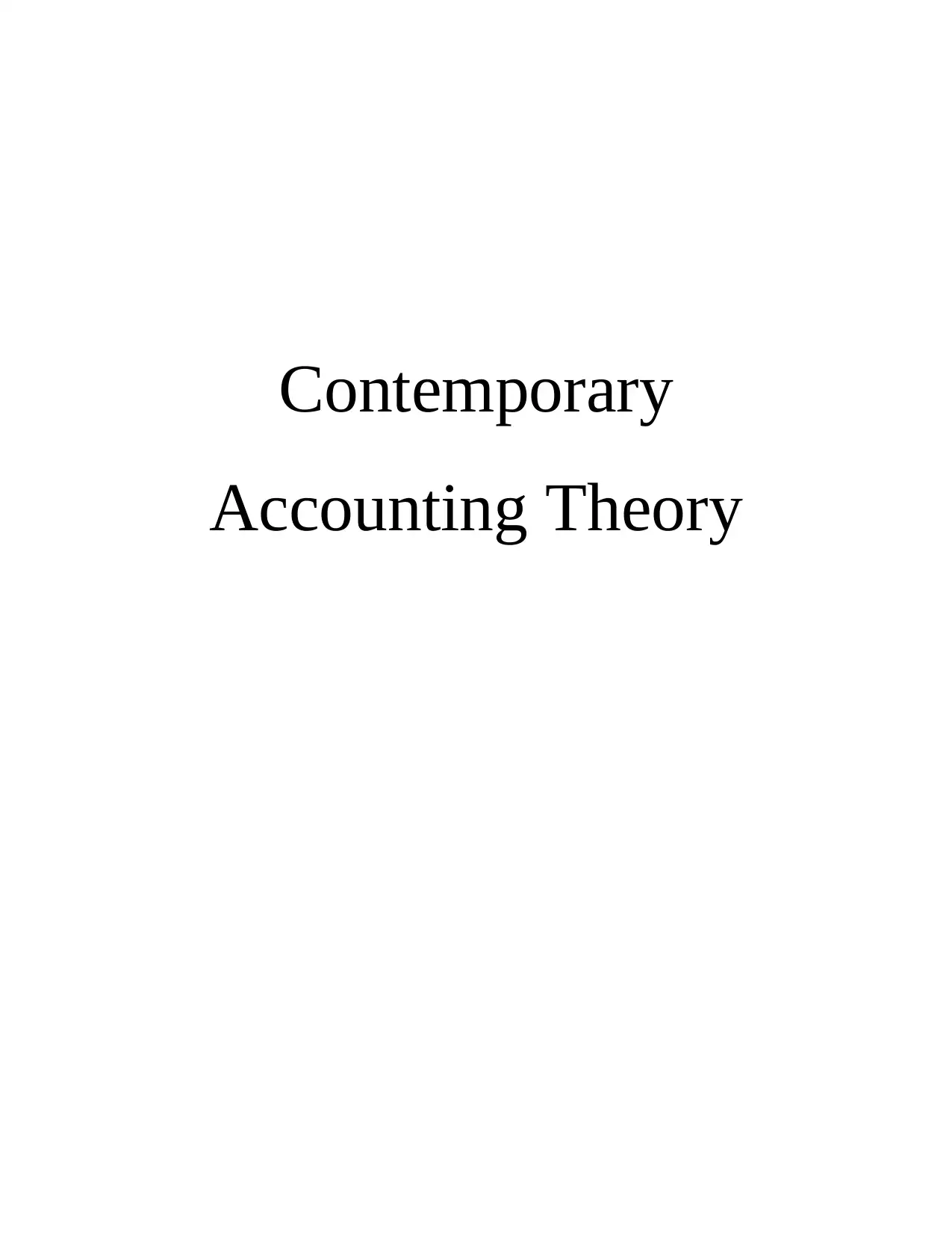
Contemporary
Accounting Theory
Accounting Theory
Paraphrase This Document
Need a fresh take? Get an instant paraphrase of this document with our AI Paraphraser
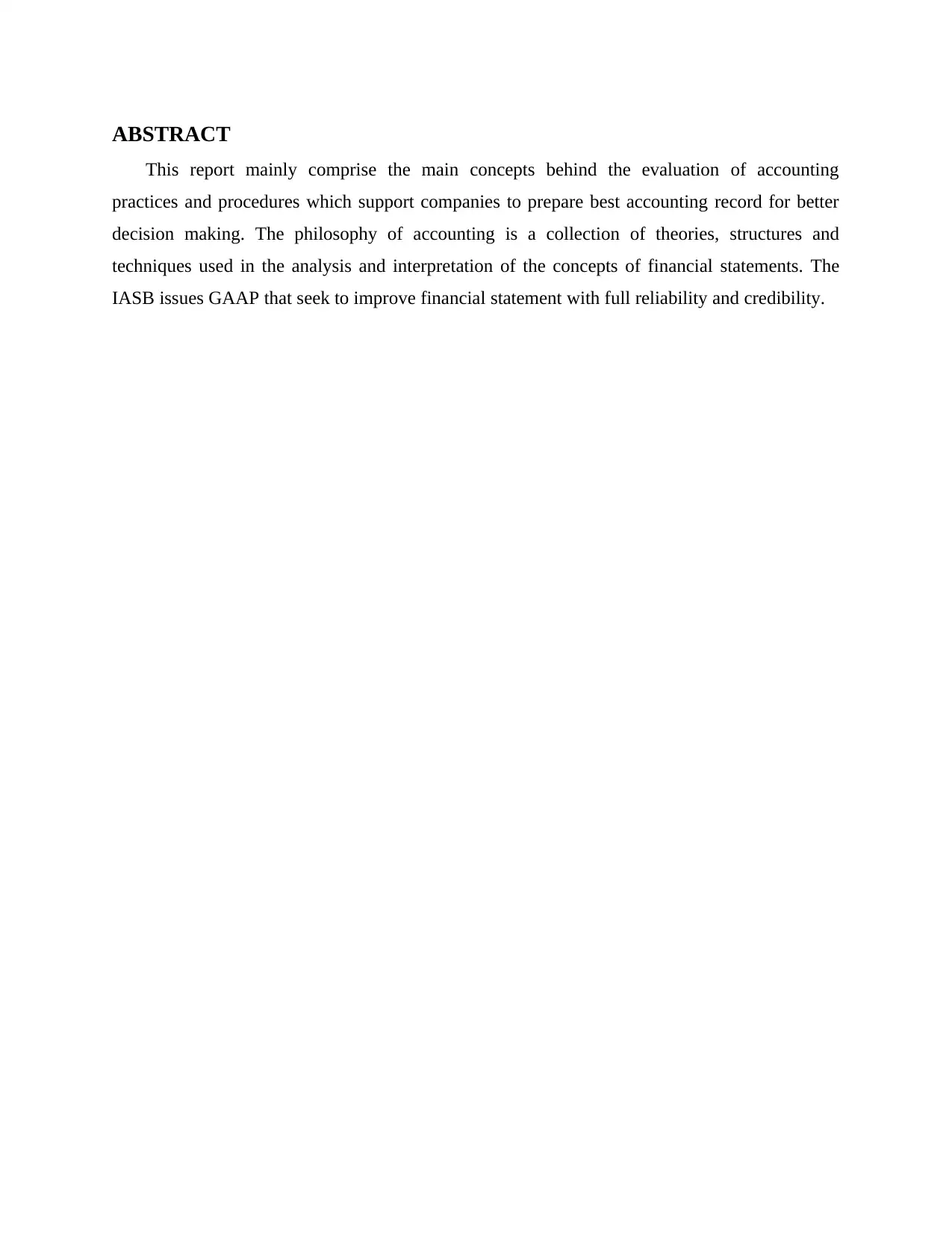
ABSTRACT
This report mainly comprise the main concepts behind the evaluation of accounting
practices and procedures which support companies to prepare best accounting record for better
decision making. The philosophy of accounting is a collection of theories, structures and
techniques used in the analysis and interpretation of the concepts of financial statements. The
IASB issues GAAP that seek to improve financial statement with full reliability and credibility.
This report mainly comprise the main concepts behind the evaluation of accounting
practices and procedures which support companies to prepare best accounting record for better
decision making. The philosophy of accounting is a collection of theories, structures and
techniques used in the analysis and interpretation of the concepts of financial statements. The
IASB issues GAAP that seek to improve financial statement with full reliability and credibility.
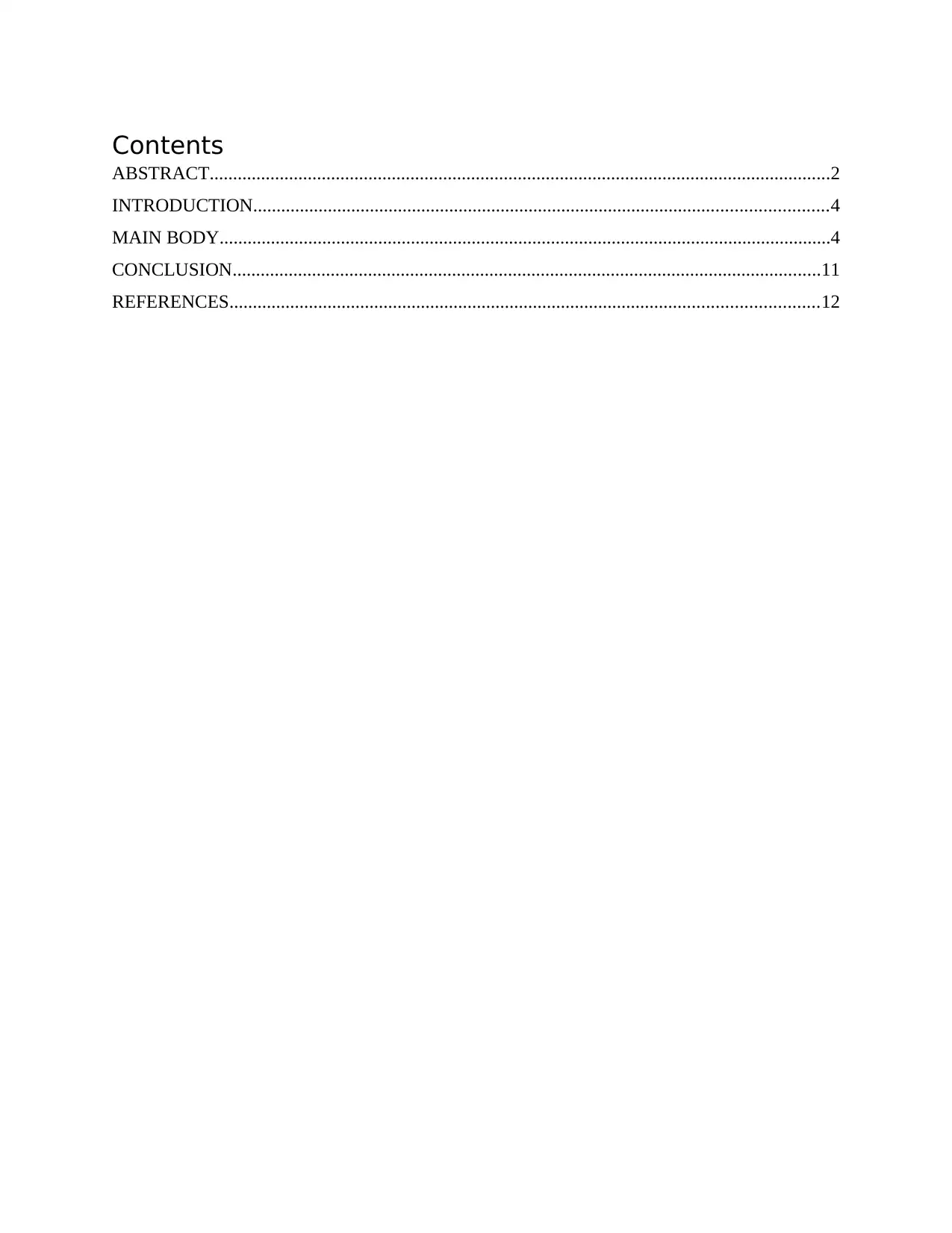
Contents
ABSTRACT.....................................................................................................................................2
INTRODUCTION...........................................................................................................................4
MAIN BODY...................................................................................................................................4
CONCLUSION..............................................................................................................................11
REFERENCES..............................................................................................................................12
ABSTRACT.....................................................................................................................................2
INTRODUCTION...........................................................................................................................4
MAIN BODY...................................................................................................................................4
CONCLUSION..............................................................................................................................11
REFERENCES..............................................................................................................................12
⊘ This is a preview!⊘
Do you want full access?
Subscribe today to unlock all pages.

Trusted by 1+ million students worldwide
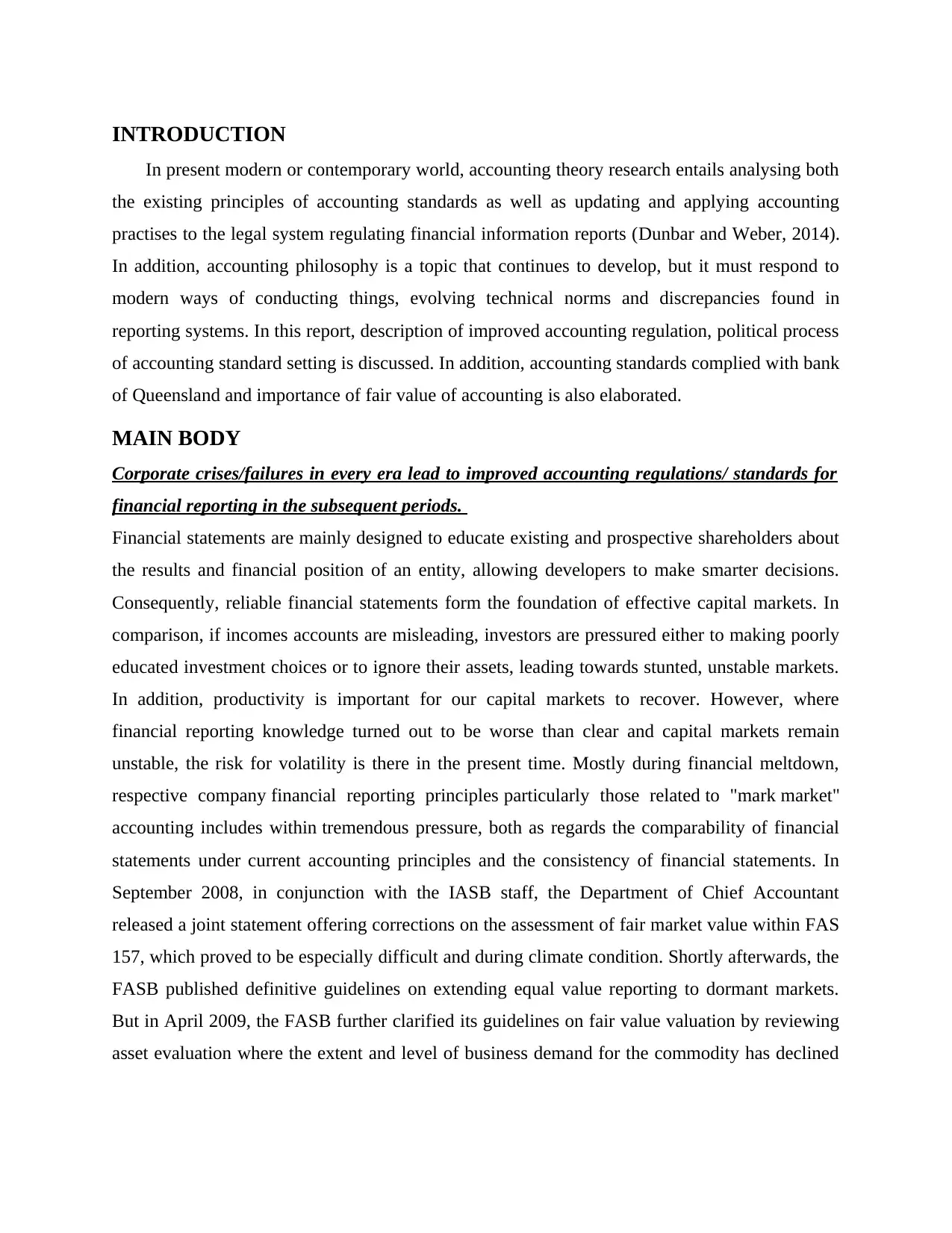
INTRODUCTION
In present modern or contemporary world, accounting theory research entails analysing both
the existing principles of accounting standards as well as updating and applying accounting
practises to the legal system regulating financial information reports (Dunbar and Weber, 2014).
In addition, accounting philosophy is a topic that continues to develop, but it must respond to
modern ways of conducting things, evolving technical norms and discrepancies found in
reporting systems. In this report, description of improved accounting regulation, political process
of accounting standard setting is discussed. In addition, accounting standards complied with bank
of Queensland and importance of fair value of accounting is also elaborated.
MAIN BODY
Corporate crises/failures in every era lead to improved accounting regulations/ standards for
financial reporting in the subsequent periods.
Financial statements are mainly designed to educate existing and prospective shareholders about
the results and financial position of an entity, allowing developers to make smarter decisions.
Consequently, reliable financial statements form the foundation of effective capital markets. In
comparison, if incomes accounts are misleading, investors are pressured either to making poorly
educated investment choices or to ignore their assets, leading towards stunted, unstable markets.
In addition, productivity is important for our capital markets to recover. However, where
financial reporting knowledge turned out to be worse than clear and capital markets remain
unstable, the risk for volatility is there in the present time. Mostly during financial meltdown,
respective company financial reporting principles particularly those related to "mark market"
accounting includes within tremendous pressure, both as regards the comparability of financial
statements under current accounting principles and the consistency of financial statements. In
September 2008, in conjunction with the IASB staff, the Department of Chief Accountant
released a joint statement offering corrections on the assessment of fair market value within FAS
157, which proved to be especially difficult and during climate condition. Shortly afterwards, the
FASB published definitive guidelines on extending equal value reporting to dormant markets.
But in April 2009, the FASB further clarified its guidelines on fair value valuation by reviewing
asset evaluation where the extent and level of business demand for the commodity has declined
In present modern or contemporary world, accounting theory research entails analysing both
the existing principles of accounting standards as well as updating and applying accounting
practises to the legal system regulating financial information reports (Dunbar and Weber, 2014).
In addition, accounting philosophy is a topic that continues to develop, but it must respond to
modern ways of conducting things, evolving technical norms and discrepancies found in
reporting systems. In this report, description of improved accounting regulation, political process
of accounting standard setting is discussed. In addition, accounting standards complied with bank
of Queensland and importance of fair value of accounting is also elaborated.
MAIN BODY
Corporate crises/failures in every era lead to improved accounting regulations/ standards for
financial reporting in the subsequent periods.
Financial statements are mainly designed to educate existing and prospective shareholders about
the results and financial position of an entity, allowing developers to make smarter decisions.
Consequently, reliable financial statements form the foundation of effective capital markets. In
comparison, if incomes accounts are misleading, investors are pressured either to making poorly
educated investment choices or to ignore their assets, leading towards stunted, unstable markets.
In addition, productivity is important for our capital markets to recover. However, where
financial reporting knowledge turned out to be worse than clear and capital markets remain
unstable, the risk for volatility is there in the present time. Mostly during financial meltdown,
respective company financial reporting principles particularly those related to "mark market"
accounting includes within tremendous pressure, both as regards the comparability of financial
statements under current accounting principles and the consistency of financial statements. In
September 2008, in conjunction with the IASB staff, the Department of Chief Accountant
released a joint statement offering corrections on the assessment of fair market value within FAS
157, which proved to be especially difficult and during climate condition. Shortly afterwards, the
FASB published definitive guidelines on extending equal value reporting to dormant markets.
But in April 2009, the FASB further clarified its guidelines on fair value valuation by reviewing
asset evaluation where the extent and level of business demand for the commodity has declined
Paraphrase This Document
Need a fresh take? Get an instant paraphrase of this document with our AI Paraphraser
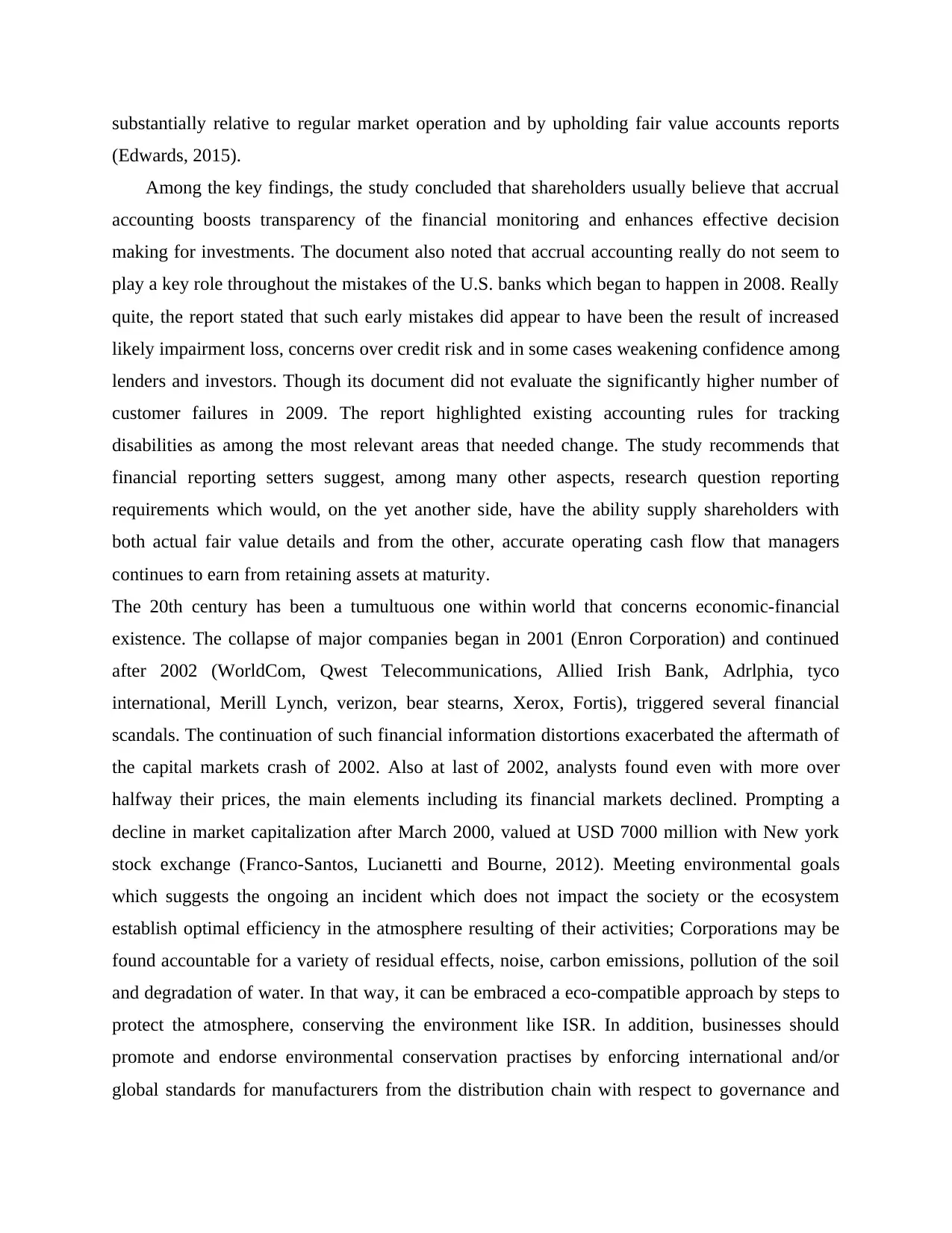
substantially relative to regular market operation and by upholding fair value accounts reports
(Edwards, 2015).
Among the key findings, the study concluded that shareholders usually believe that accrual
accounting boosts transparency of the financial monitoring and enhances effective decision
making for investments. The document also noted that accrual accounting really do not seem to
play a key role throughout the mistakes of the U.S. banks which began to happen in 2008. Really
quite, the report stated that such early mistakes did appear to have been the result of increased
likely impairment loss, concerns over credit risk and in some cases weakening confidence among
lenders and investors. Though its document did not evaluate the significantly higher number of
customer failures in 2009. The report highlighted existing accounting rules for tracking
disabilities as among the most relevant areas that needed change. The study recommends that
financial reporting setters suggest, among many other aspects, research question reporting
requirements which would, on the yet another side, have the ability supply shareholders with
both actual fair value details and from the other, accurate operating cash flow that managers
continues to earn from retaining assets at maturity.
The 20th century has been a tumultuous one within world that concerns economic-financial
existence. The collapse of major companies began in 2001 (Enron Corporation) and continued
after 2002 (WorldCom, Qwest Telecommunications, Allied Irish Bank, Adrlphia, tyco
international, Merill Lynch, verizon, bear stearns, Xerox, Fortis), triggered several financial
scandals. The continuation of such financial information distortions exacerbated the aftermath of
the capital markets crash of 2002. Also at last of 2002, analysts found even with more over
halfway their prices, the main elements including its financial markets declined. Prompting a
decline in market capitalization after March 2000, valued at USD 7000 million with New york
stock exchange (Franco-Santos, Lucianetti and Bourne, 2012). Meeting environmental goals
which suggests the ongoing an incident which does not impact the society or the ecosystem
establish optimal efficiency in the atmosphere resulting of their activities; Corporations may be
found accountable for a variety of residual effects, noise, carbon emissions, pollution of the soil
and degradation of water. In that way, it can be embraced a eco-compatible approach by steps to
protect the atmosphere, conserving the environment like ISR. In addition, businesses should
promote and endorse environmental conservation practises by enforcing international and/or
global standards for manufacturers from the distribution chain with respect to governance and
(Edwards, 2015).
Among the key findings, the study concluded that shareholders usually believe that accrual
accounting boosts transparency of the financial monitoring and enhances effective decision
making for investments. The document also noted that accrual accounting really do not seem to
play a key role throughout the mistakes of the U.S. banks which began to happen in 2008. Really
quite, the report stated that such early mistakes did appear to have been the result of increased
likely impairment loss, concerns over credit risk and in some cases weakening confidence among
lenders and investors. Though its document did not evaluate the significantly higher number of
customer failures in 2009. The report highlighted existing accounting rules for tracking
disabilities as among the most relevant areas that needed change. The study recommends that
financial reporting setters suggest, among many other aspects, research question reporting
requirements which would, on the yet another side, have the ability supply shareholders with
both actual fair value details and from the other, accurate operating cash flow that managers
continues to earn from retaining assets at maturity.
The 20th century has been a tumultuous one within world that concerns economic-financial
existence. The collapse of major companies began in 2001 (Enron Corporation) and continued
after 2002 (WorldCom, Qwest Telecommunications, Allied Irish Bank, Adrlphia, tyco
international, Merill Lynch, verizon, bear stearns, Xerox, Fortis), triggered several financial
scandals. The continuation of such financial information distortions exacerbated the aftermath of
the capital markets crash of 2002. Also at last of 2002, analysts found even with more over
halfway their prices, the main elements including its financial markets declined. Prompting a
decline in market capitalization after March 2000, valued at USD 7000 million with New york
stock exchange (Franco-Santos, Lucianetti and Bourne, 2012). Meeting environmental goals
which suggests the ongoing an incident which does not impact the society or the ecosystem
establish optimal efficiency in the atmosphere resulting of their activities; Corporations may be
found accountable for a variety of residual effects, noise, carbon emissions, pollution of the soil
and degradation of water. In that way, it can be embraced a eco-compatible approach by steps to
protect the atmosphere, conserving the environment like ISR. In addition, businesses should
promote and endorse environmental conservation practises by enforcing international and/or
global standards for manufacturers from the distribution chain with respect to governance and
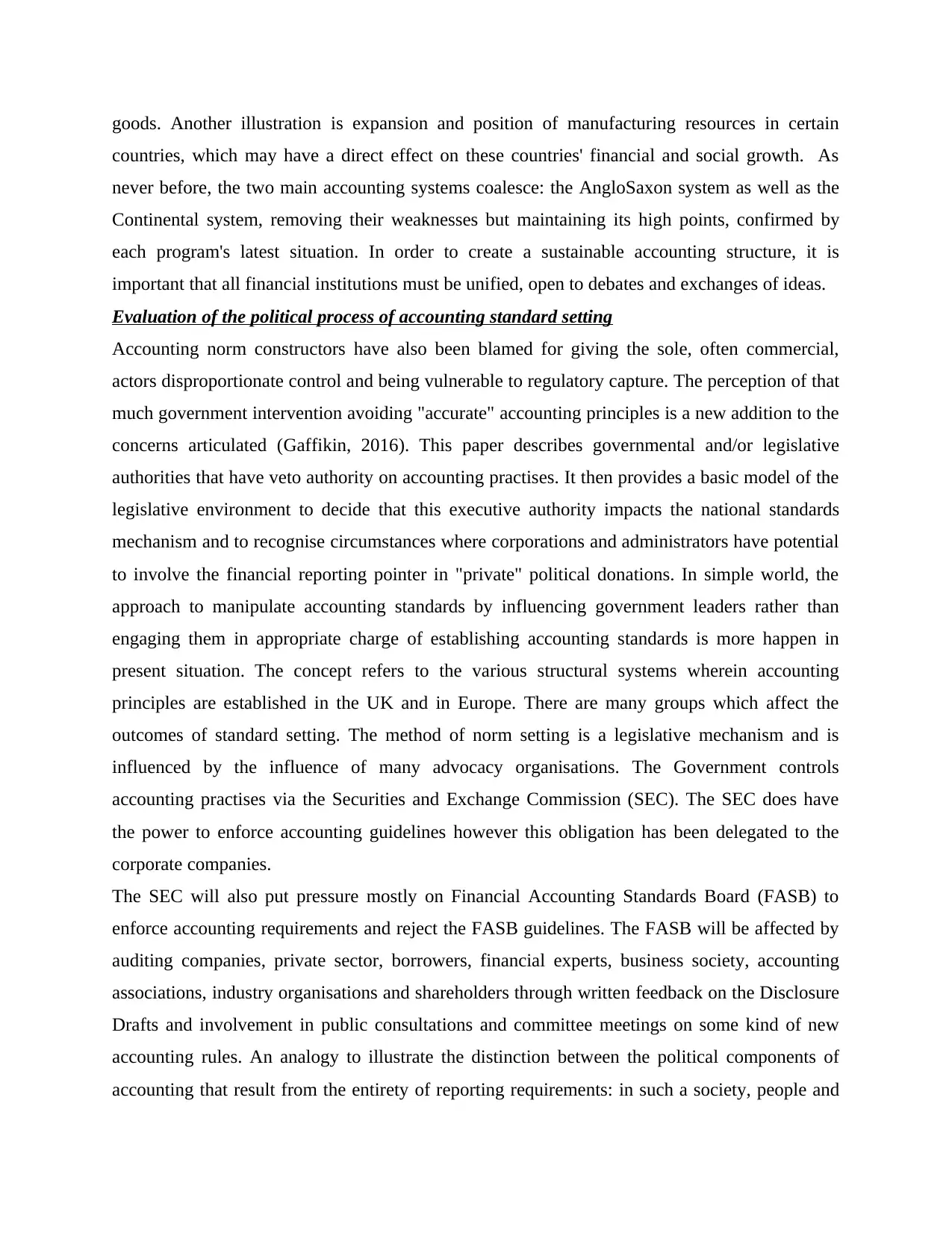
goods. Another illustration is expansion and position of manufacturing resources in certain
countries, which may have a direct effect on these countries' financial and social growth. As
never before, the two main accounting systems coalesce: the AngloSaxon system as well as the
Continental system, removing their weaknesses but maintaining its high points, confirmed by
each program's latest situation. In order to create a sustainable accounting structure, it is
important that all financial institutions must be unified, open to debates and exchanges of ideas.
Evaluation of the political process of accounting standard setting
Accounting norm constructors have also been blamed for giving the sole, often commercial,
actors disproportionate control and being vulnerable to regulatory capture. The perception of that
much government intervention avoiding "accurate" accounting principles is a new addition to the
concerns articulated (Gaffikin, 2016). This paper describes governmental and/or legislative
authorities that have veto authority on accounting practises. It then provides a basic model of the
legislative environment to decide that this executive authority impacts the national standards
mechanism and to recognise circumstances where corporations and administrators have potential
to involve the financial reporting pointer in "private" political donations. In simple world, the
approach to manipulate accounting standards by influencing government leaders rather than
engaging them in appropriate charge of establishing accounting standards is more happen in
present situation. The concept refers to the various structural systems wherein accounting
principles are established in the UK and in Europe. There are many groups which affect the
outcomes of standard setting. The method of norm setting is a legislative mechanism and is
influenced by the influence of many advocacy organisations. The Government controls
accounting practises via the Securities and Exchange Commission (SEC). The SEC does have
the power to enforce accounting guidelines however this obligation has been delegated to the
corporate companies.
The SEC will also put pressure mostly on Financial Accounting Standards Board (FASB) to
enforce accounting requirements and reject the FASB guidelines. The FASB will be affected by
auditing companies, private sector, borrowers, financial experts, business society, accounting
associations, industry organisations and shareholders through written feedback on the Disclosure
Drafts and involvement in public consultations and committee meetings on some kind of new
accounting rules. An analogy to illustrate the distinction between the political components of
accounting that result from the entirety of reporting requirements: in such a society, people and
countries, which may have a direct effect on these countries' financial and social growth. As
never before, the two main accounting systems coalesce: the AngloSaxon system as well as the
Continental system, removing their weaknesses but maintaining its high points, confirmed by
each program's latest situation. In order to create a sustainable accounting structure, it is
important that all financial institutions must be unified, open to debates and exchanges of ideas.
Evaluation of the political process of accounting standard setting
Accounting norm constructors have also been blamed for giving the sole, often commercial,
actors disproportionate control and being vulnerable to regulatory capture. The perception of that
much government intervention avoiding "accurate" accounting principles is a new addition to the
concerns articulated (Gaffikin, 2016). This paper describes governmental and/or legislative
authorities that have veto authority on accounting practises. It then provides a basic model of the
legislative environment to decide that this executive authority impacts the national standards
mechanism and to recognise circumstances where corporations and administrators have potential
to involve the financial reporting pointer in "private" political donations. In simple world, the
approach to manipulate accounting standards by influencing government leaders rather than
engaging them in appropriate charge of establishing accounting standards is more happen in
present situation. The concept refers to the various structural systems wherein accounting
principles are established in the UK and in Europe. There are many groups which affect the
outcomes of standard setting. The method of norm setting is a legislative mechanism and is
influenced by the influence of many advocacy organisations. The Government controls
accounting practises via the Securities and Exchange Commission (SEC). The SEC does have
the power to enforce accounting guidelines however this obligation has been delegated to the
corporate companies.
The SEC will also put pressure mostly on Financial Accounting Standards Board (FASB) to
enforce accounting requirements and reject the FASB guidelines. The FASB will be affected by
auditing companies, private sector, borrowers, financial experts, business society, accounting
associations, industry organisations and shareholders through written feedback on the Disclosure
Drafts and involvement in public consultations and committee meetings on some kind of new
accounting rules. An analogy to illustrate the distinction between the political components of
accounting that result from the entirety of reporting requirements: in such a society, people and
⊘ This is a preview!⊘
Do you want full access?
Subscribe today to unlock all pages.

Trusted by 1+ million students worldwide
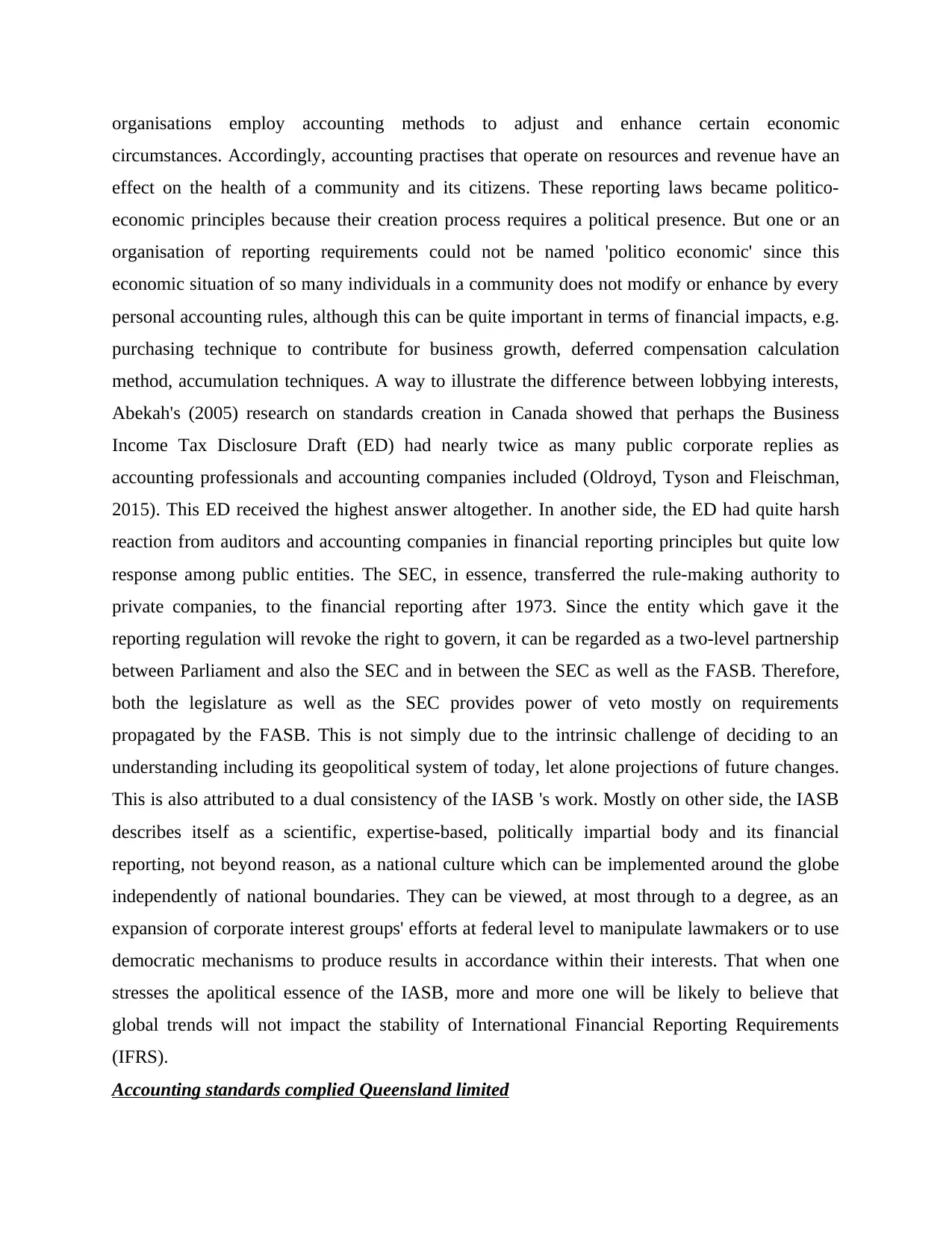
organisations employ accounting methods to adjust and enhance certain economic
circumstances. Accordingly, accounting practises that operate on resources and revenue have an
effect on the health of a community and its citizens. These reporting laws became politico-
economic principles because their creation process requires a political presence. But one or an
organisation of reporting requirements could not be named 'politico economic' since this
economic situation of so many individuals in a community does not modify or enhance by every
personal accounting rules, although this can be quite important in terms of financial impacts, e.g.
purchasing technique to contribute for business growth, deferred compensation calculation
method, accumulation techniques. A way to illustrate the difference between lobbying interests,
Abekah's (2005) research on standards creation in Canada showed that perhaps the Business
Income Tax Disclosure Draft (ED) had nearly twice as many public corporate replies as
accounting professionals and accounting companies included (Oldroyd, Tyson and Fleischman,
2015). This ED received the highest answer altogether. In another side, the ED had quite harsh
reaction from auditors and accounting companies in financial reporting principles but quite low
response among public entities. The SEC, in essence, transferred the rule-making authority to
private companies, to the financial reporting after 1973. Since the entity which gave it the
reporting regulation will revoke the right to govern, it can be regarded as a two-level partnership
between Parliament and also the SEC and in between the SEC as well as the FASB. Therefore,
both the legislature as well as the SEC provides power of veto mostly on requirements
propagated by the FASB. This is not simply due to the intrinsic challenge of deciding to an
understanding including its geopolitical system of today, let alone projections of future changes.
This is also attributed to a dual consistency of the IASB 's work. Mostly on other side, the IASB
describes itself as a scientific, expertise-based, politically impartial body and its financial
reporting, not beyond reason, as a national culture which can be implemented around the globe
independently of national boundaries. They can be viewed, at most through to a degree, as an
expansion of corporate interest groups' efforts at federal level to manipulate lawmakers or to use
democratic mechanisms to produce results in accordance within their interests. That when one
stresses the apolitical essence of the IASB, more and more one will be likely to believe that
global trends will not impact the stability of International Financial Reporting Requirements
(IFRS).
Accounting standards complied Queensland limited
circumstances. Accordingly, accounting practises that operate on resources and revenue have an
effect on the health of a community and its citizens. These reporting laws became politico-
economic principles because their creation process requires a political presence. But one or an
organisation of reporting requirements could not be named 'politico economic' since this
economic situation of so many individuals in a community does not modify or enhance by every
personal accounting rules, although this can be quite important in terms of financial impacts, e.g.
purchasing technique to contribute for business growth, deferred compensation calculation
method, accumulation techniques. A way to illustrate the difference between lobbying interests,
Abekah's (2005) research on standards creation in Canada showed that perhaps the Business
Income Tax Disclosure Draft (ED) had nearly twice as many public corporate replies as
accounting professionals and accounting companies included (Oldroyd, Tyson and Fleischman,
2015). This ED received the highest answer altogether. In another side, the ED had quite harsh
reaction from auditors and accounting companies in financial reporting principles but quite low
response among public entities. The SEC, in essence, transferred the rule-making authority to
private companies, to the financial reporting after 1973. Since the entity which gave it the
reporting regulation will revoke the right to govern, it can be regarded as a two-level partnership
between Parliament and also the SEC and in between the SEC as well as the FASB. Therefore,
both the legislature as well as the SEC provides power of veto mostly on requirements
propagated by the FASB. This is not simply due to the intrinsic challenge of deciding to an
understanding including its geopolitical system of today, let alone projections of future changes.
This is also attributed to a dual consistency of the IASB 's work. Mostly on other side, the IASB
describes itself as a scientific, expertise-based, politically impartial body and its financial
reporting, not beyond reason, as a national culture which can be implemented around the globe
independently of national boundaries. They can be viewed, at most through to a degree, as an
expansion of corporate interest groups' efforts at federal level to manipulate lawmakers or to use
democratic mechanisms to produce results in accordance within their interests. That when one
stresses the apolitical essence of the IASB, more and more one will be likely to believe that
global trends will not impact the stability of International Financial Reporting Requirements
(IFRS).
Accounting standards complied Queensland limited
Paraphrase This Document
Need a fresh take? Get an instant paraphrase of this document with our AI Paraphraser
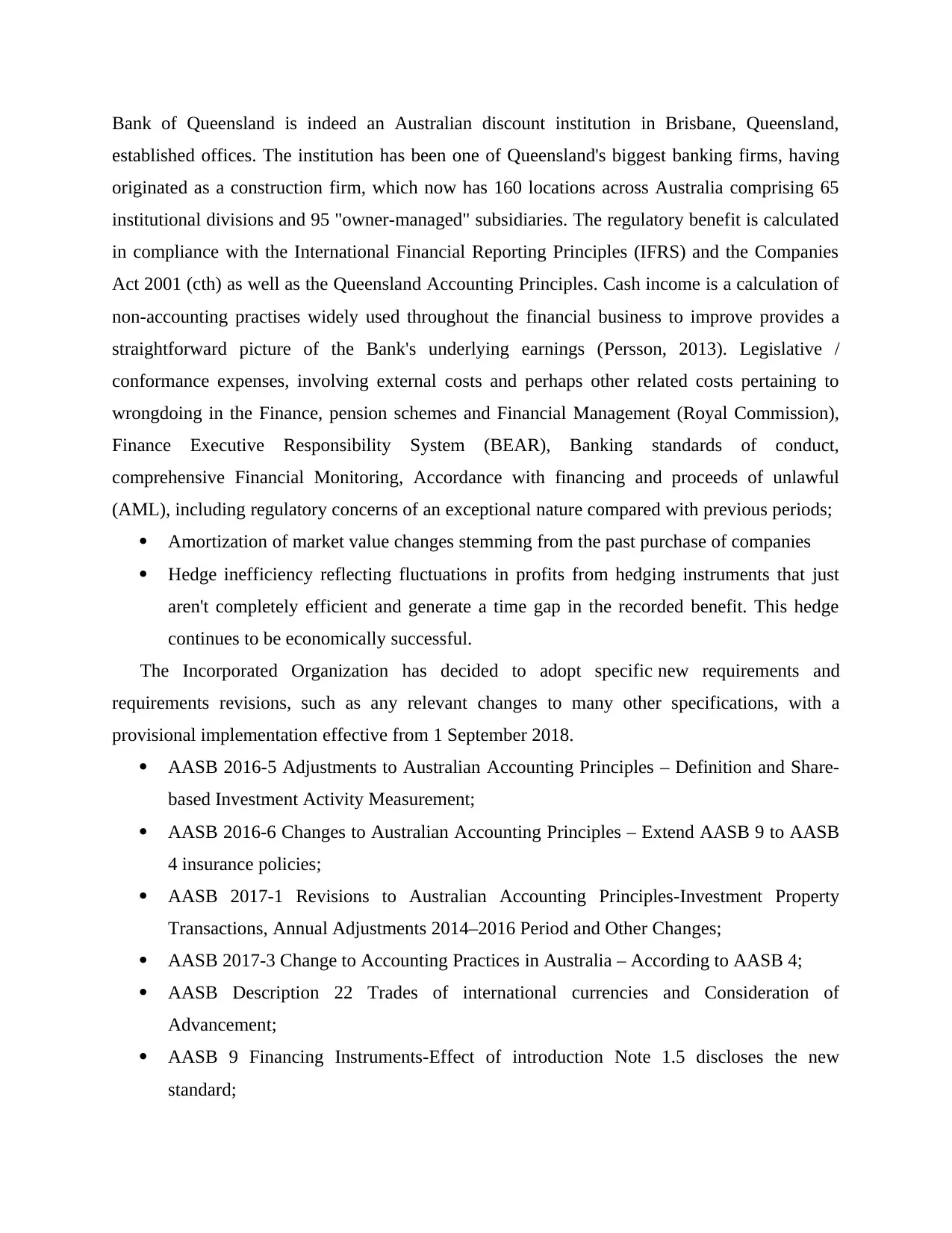
Bank of Queensland is indeed an Australian discount institution in Brisbane, Queensland,
established offices. The institution has been one of Queensland's biggest banking firms, having
originated as a construction firm, which now has 160 locations across Australia comprising 65
institutional divisions and 95 "owner-managed" subsidiaries. The regulatory benefit is calculated
in compliance with the International Financial Reporting Principles (IFRS) and the Companies
Act 2001 (cth) as well as the Queensland Accounting Principles. Cash income is a calculation of
non-accounting practises widely used throughout the financial business to improve provides a
straightforward picture of the Bank's underlying earnings (Persson, 2013). Legislative /
conformance expenses, involving external costs and perhaps other related costs pertaining to
wrongdoing in the Finance, pension schemes and Financial Management (Royal Commission),
Finance Executive Responsibility System (BEAR), Banking standards of conduct,
comprehensive Financial Monitoring, Accordance with financing and proceeds of unlawful
(AML), including regulatory concerns of an exceptional nature compared with previous periods;
Amortization of market value changes stemming from the past purchase of companies
Hedge inefficiency reflecting fluctuations in profits from hedging instruments that just
aren't completely efficient and generate a time gap in the recorded benefit. This hedge
continues to be economically successful.
The Incorporated Organization has decided to adopt specific new requirements and
requirements revisions, such as any relevant changes to many other specifications, with a
provisional implementation effective from 1 September 2018.
AASB 2016-5 Adjustments to Australian Accounting Principles – Definition and Share-
based Investment Activity Measurement;
AASB 2016-6 Changes to Australian Accounting Principles – Extend AASB 9 to AASB
4 insurance policies;
AASB 2017-1 Revisions to Australian Accounting Principles-Investment Property
Transactions, Annual Adjustments 2014–2016 Period and Other Changes;
AASB 2017-3 Change to Accounting Practices in Australia – According to AASB 4;
AASB Description 22 Trades of international currencies and Consideration of
Advancement;
AASB 9 Financing Instruments-Effect of introduction Note 1.5 discloses the new
standard;
established offices. The institution has been one of Queensland's biggest banking firms, having
originated as a construction firm, which now has 160 locations across Australia comprising 65
institutional divisions and 95 "owner-managed" subsidiaries. The regulatory benefit is calculated
in compliance with the International Financial Reporting Principles (IFRS) and the Companies
Act 2001 (cth) as well as the Queensland Accounting Principles. Cash income is a calculation of
non-accounting practises widely used throughout the financial business to improve provides a
straightforward picture of the Bank's underlying earnings (Persson, 2013). Legislative /
conformance expenses, involving external costs and perhaps other related costs pertaining to
wrongdoing in the Finance, pension schemes and Financial Management (Royal Commission),
Finance Executive Responsibility System (BEAR), Banking standards of conduct,
comprehensive Financial Monitoring, Accordance with financing and proceeds of unlawful
(AML), including regulatory concerns of an exceptional nature compared with previous periods;
Amortization of market value changes stemming from the past purchase of companies
Hedge inefficiency reflecting fluctuations in profits from hedging instruments that just
aren't completely efficient and generate a time gap in the recorded benefit. This hedge
continues to be economically successful.
The Incorporated Organization has decided to adopt specific new requirements and
requirements revisions, such as any relevant changes to many other specifications, with a
provisional implementation effective from 1 September 2018.
AASB 2016-5 Adjustments to Australian Accounting Principles – Definition and Share-
based Investment Activity Measurement;
AASB 2016-6 Changes to Australian Accounting Principles – Extend AASB 9 to AASB
4 insurance policies;
AASB 2017-1 Revisions to Australian Accounting Principles-Investment Property
Transactions, Annual Adjustments 2014–2016 Period and Other Changes;
AASB 2017-3 Change to Accounting Practices in Australia – According to AASB 4;
AASB Description 22 Trades of international currencies and Consideration of
Advancement;
AASB 9 Financing Instruments-Effect of introduction Note 1.5 discloses the new
standard;
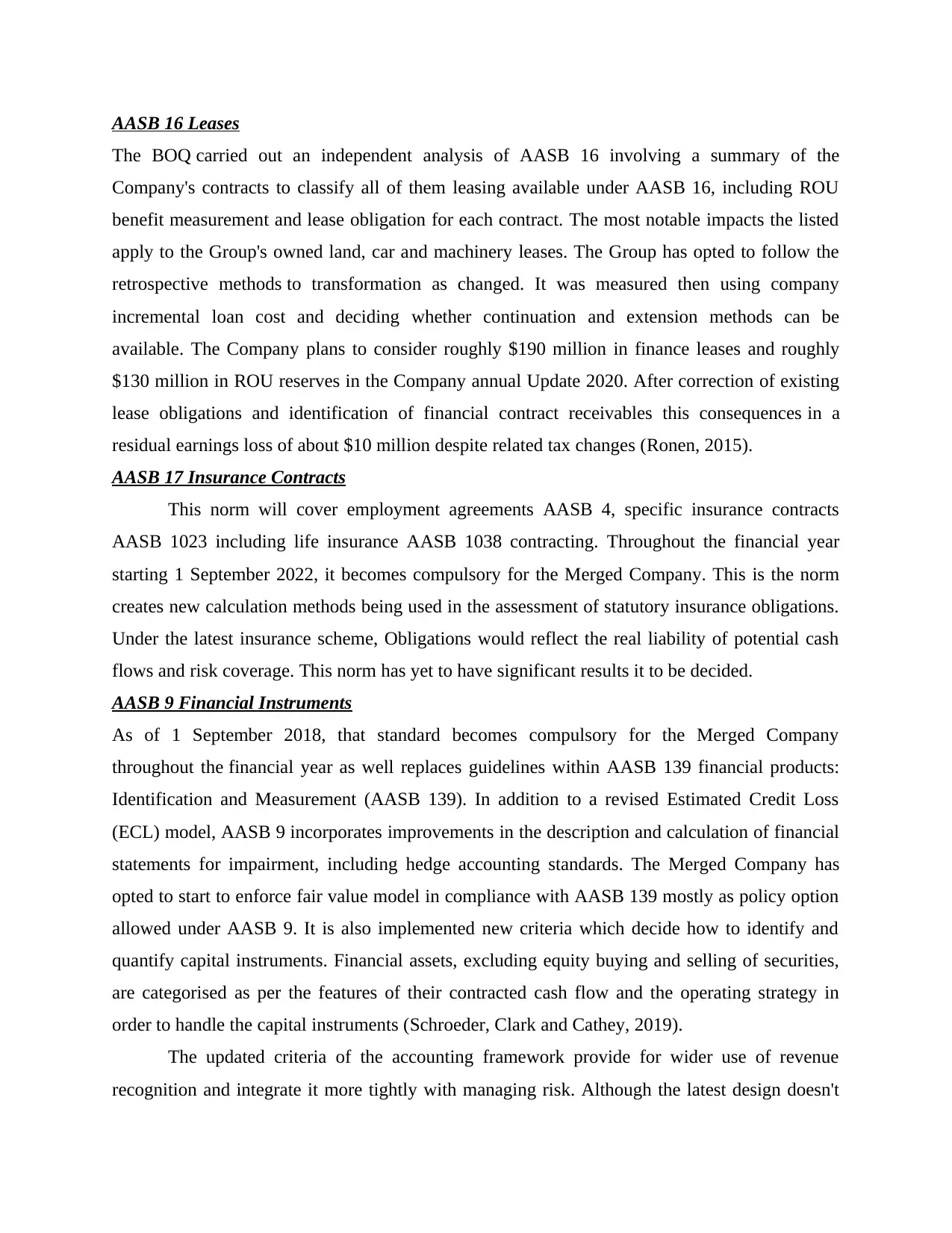
AASB 16 Leases
The BOQ carried out an independent analysis of AASB 16 involving a summary of the
Company's contracts to classify all of them leasing available under AASB 16, including ROU
benefit measurement and lease obligation for each contract. The most notable impacts the listed
apply to the Group's owned land, car and machinery leases. The Group has opted to follow the
retrospective methods to transformation as changed. It was measured then using company
incremental loan cost and deciding whether continuation and extension methods can be
available. The Company plans to consider roughly $190 million in finance leases and roughly
$130 million in ROU reserves in the Company annual Update 2020. After correction of existing
lease obligations and identification of financial contract receivables this consequences in a
residual earnings loss of about $10 million despite related tax changes (Ronen, 2015).
AASB 17 Insurance Contracts
This norm will cover employment agreements AASB 4, specific insurance contracts
AASB 1023 including life insurance AASB 1038 contracting. Throughout the financial year
starting 1 September 2022, it becomes compulsory for the Merged Company. This is the norm
creates new calculation methods being used in the assessment of statutory insurance obligations.
Under the latest insurance scheme, Obligations would reflect the real liability of potential cash
flows and risk coverage. This norm has yet to have significant results it to be decided.
AASB 9 Financial Instruments
As of 1 September 2018, that standard becomes compulsory for the Merged Company
throughout the financial year as well replaces guidelines within AASB 139 financial products:
Identification and Measurement (AASB 139). In addition to a revised Estimated Credit Loss
(ECL) model, AASB 9 incorporates improvements in the description and calculation of financial
statements for impairment, including hedge accounting standards. The Merged Company has
opted to start to enforce fair value model in compliance with AASB 139 mostly as policy option
allowed under AASB 9. It is also implemented new criteria which decide how to identify and
quantify capital instruments. Financial assets, excluding equity buying and selling of securities,
are categorised as per the features of their contracted cash flow and the operating strategy in
order to handle the capital instruments (Schroeder, Clark and Cathey, 2019).
The updated criteria of the accounting framework provide for wider use of revenue
recognition and integrate it more tightly with managing risk. Although the latest design doesn't
The BOQ carried out an independent analysis of AASB 16 involving a summary of the
Company's contracts to classify all of them leasing available under AASB 16, including ROU
benefit measurement and lease obligation for each contract. The most notable impacts the listed
apply to the Group's owned land, car and machinery leases. The Group has opted to follow the
retrospective methods to transformation as changed. It was measured then using company
incremental loan cost and deciding whether continuation and extension methods can be
available. The Company plans to consider roughly $190 million in finance leases and roughly
$130 million in ROU reserves in the Company annual Update 2020. After correction of existing
lease obligations and identification of financial contract receivables this consequences in a
residual earnings loss of about $10 million despite related tax changes (Ronen, 2015).
AASB 17 Insurance Contracts
This norm will cover employment agreements AASB 4, specific insurance contracts
AASB 1023 including life insurance AASB 1038 contracting. Throughout the financial year
starting 1 September 2022, it becomes compulsory for the Merged Company. This is the norm
creates new calculation methods being used in the assessment of statutory insurance obligations.
Under the latest insurance scheme, Obligations would reflect the real liability of potential cash
flows and risk coverage. This norm has yet to have significant results it to be decided.
AASB 9 Financial Instruments
As of 1 September 2018, that standard becomes compulsory for the Merged Company
throughout the financial year as well replaces guidelines within AASB 139 financial products:
Identification and Measurement (AASB 139). In addition to a revised Estimated Credit Loss
(ECL) model, AASB 9 incorporates improvements in the description and calculation of financial
statements for impairment, including hedge accounting standards. The Merged Company has
opted to start to enforce fair value model in compliance with AASB 139 mostly as policy option
allowed under AASB 9. It is also implemented new criteria which decide how to identify and
quantify capital instruments. Financial assets, excluding equity buying and selling of securities,
are categorised as per the features of their contracted cash flow and the operating strategy in
order to handle the capital instruments (Schroeder, Clark and Cathey, 2019).
The updated criteria of the accounting framework provide for wider use of revenue
recognition and integrate it more tightly with managing risk. Although the latest design doesn't
⊘ This is a preview!⊘
Do you want full access?
Subscribe today to unlock all pages.

Trusted by 1+ million students worldwide
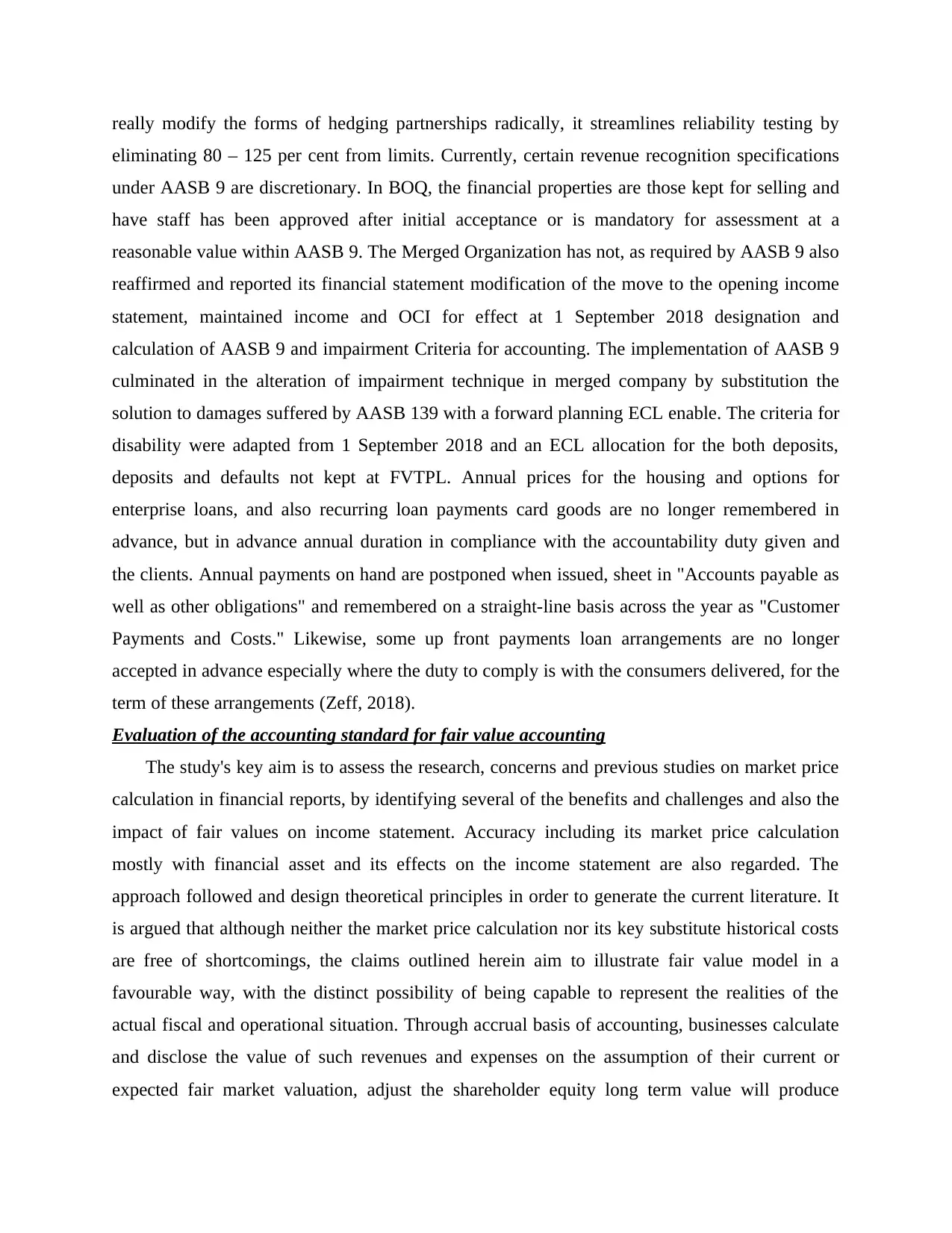
really modify the forms of hedging partnerships radically, it streamlines reliability testing by
eliminating 80 – 125 per cent from limits. Currently, certain revenue recognition specifications
under AASB 9 are discretionary. In BOQ, the financial properties are those kept for selling and
have staff has been approved after initial acceptance or is mandatory for assessment at a
reasonable value within AASB 9. The Merged Organization has not, as required by AASB 9 also
reaffirmed and reported its financial statement modification of the move to the opening income
statement, maintained income and OCI for effect at 1 September 2018 designation and
calculation of AASB 9 and impairment Criteria for accounting. The implementation of AASB 9
culminated in the alteration of impairment technique in merged company by substitution the
solution to damages suffered by AASB 139 with a forward planning ECL enable. The criteria for
disability were adapted from 1 September 2018 and an ECL allocation for the both deposits,
deposits and defaults not kept at FVTPL. Annual prices for the housing and options for
enterprise loans, and also recurring loan payments card goods are no longer remembered in
advance, but in advance annual duration in compliance with the accountability duty given and
the clients. Annual payments on hand are postponed when issued, sheet in "Accounts payable as
well as other obligations" and remembered on a straight-line basis across the year as "Customer
Payments and Costs." Likewise, some up front payments loan arrangements are no longer
accepted in advance especially where the duty to comply is with the consumers delivered, for the
term of these arrangements (Zeff, 2018).
Evaluation of the accounting standard for fair value accounting
The study's key aim is to assess the research, concerns and previous studies on market price
calculation in financial reports, by identifying several of the benefits and challenges and also the
impact of fair values on income statement. Accuracy including its market price calculation
mostly with financial asset and its effects on the income statement are also regarded. The
approach followed and design theoretical principles in order to generate the current literature. It
is argued that although neither the market price calculation nor its key substitute historical costs
are free of shortcomings, the claims outlined herein aim to illustrate fair value model in a
favourable way, with the distinct possibility of being capable to represent the realities of the
actual fiscal and operational situation. Through accrual basis of accounting, businesses calculate
and disclose the value of such revenues and expenses on the assumption of their current or
expected fair market valuation, adjust the shareholder equity long term value will produce
eliminating 80 – 125 per cent from limits. Currently, certain revenue recognition specifications
under AASB 9 are discretionary. In BOQ, the financial properties are those kept for selling and
have staff has been approved after initial acceptance or is mandatory for assessment at a
reasonable value within AASB 9. The Merged Organization has not, as required by AASB 9 also
reaffirmed and reported its financial statement modification of the move to the opening income
statement, maintained income and OCI for effect at 1 September 2018 designation and
calculation of AASB 9 and impairment Criteria for accounting. The implementation of AASB 9
culminated in the alteration of impairment technique in merged company by substitution the
solution to damages suffered by AASB 139 with a forward planning ECL enable. The criteria for
disability were adapted from 1 September 2018 and an ECL allocation for the both deposits,
deposits and defaults not kept at FVTPL. Annual prices for the housing and options for
enterprise loans, and also recurring loan payments card goods are no longer remembered in
advance, but in advance annual duration in compliance with the accountability duty given and
the clients. Annual payments on hand are postponed when issued, sheet in "Accounts payable as
well as other obligations" and remembered on a straight-line basis across the year as "Customer
Payments and Costs." Likewise, some up front payments loan arrangements are no longer
accepted in advance especially where the duty to comply is with the consumers delivered, for the
term of these arrangements (Zeff, 2018).
Evaluation of the accounting standard for fair value accounting
The study's key aim is to assess the research, concerns and previous studies on market price
calculation in financial reports, by identifying several of the benefits and challenges and also the
impact of fair values on income statement. Accuracy including its market price calculation
mostly with financial asset and its effects on the income statement are also regarded. The
approach followed and design theoretical principles in order to generate the current literature. It
is argued that although neither the market price calculation nor its key substitute historical costs
are free of shortcomings, the claims outlined herein aim to illustrate fair value model in a
favourable way, with the distinct possibility of being capable to represent the realities of the
actual fiscal and operational situation. Through accrual basis of accounting, businesses calculate
and disclose the value of such revenues and expenses on the assumption of their current or
expected fair market valuation, adjust the shareholder equity long term value will produce
Paraphrase This Document
Need a fresh take? Get an instant paraphrase of this document with our AI Paraphraser
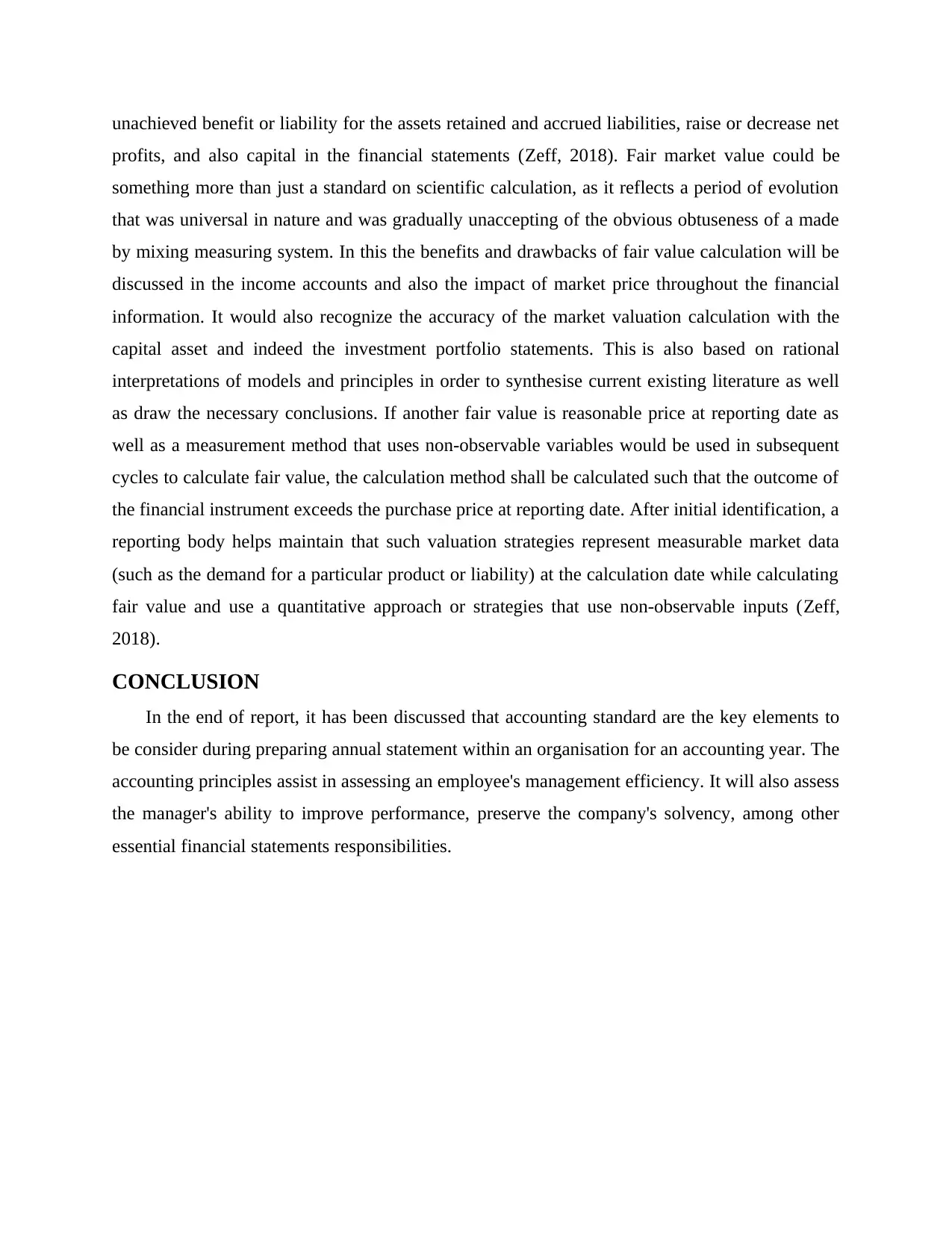
unachieved benefit or liability for the assets retained and accrued liabilities, raise or decrease net
profits, and also capital in the financial statements (Zeff, 2018). Fair market value could be
something more than just a standard on scientific calculation, as it reflects a period of evolution
that was universal in nature and was gradually unaccepting of the obvious obtuseness of a made
by mixing measuring system. In this the benefits and drawbacks of fair value calculation will be
discussed in the income accounts and also the impact of market price throughout the financial
information. It would also recognize the accuracy of the market valuation calculation with the
capital asset and indeed the investment portfolio statements. This is also based on rational
interpretations of models and principles in order to synthesise current existing literature as well
as draw the necessary conclusions. If another fair value is reasonable price at reporting date as
well as a measurement method that uses non-observable variables would be used in subsequent
cycles to calculate fair value, the calculation method shall be calculated such that the outcome of
the financial instrument exceeds the purchase price at reporting date. After initial identification, a
reporting body helps maintain that such valuation strategies represent measurable market data
(such as the demand for a particular product or liability) at the calculation date while calculating
fair value and use a quantitative approach or strategies that use non-observable inputs (Zeff,
2018).
CONCLUSION
In the end of report, it has been discussed that accounting standard are the key elements to
be consider during preparing annual statement within an organisation for an accounting year. The
accounting principles assist in assessing an employee's management efficiency. It will also assess
the manager's ability to improve performance, preserve the company's solvency, among other
essential financial statements responsibilities.
profits, and also capital in the financial statements (Zeff, 2018). Fair market value could be
something more than just a standard on scientific calculation, as it reflects a period of evolution
that was universal in nature and was gradually unaccepting of the obvious obtuseness of a made
by mixing measuring system. In this the benefits and drawbacks of fair value calculation will be
discussed in the income accounts and also the impact of market price throughout the financial
information. It would also recognize the accuracy of the market valuation calculation with the
capital asset and indeed the investment portfolio statements. This is also based on rational
interpretations of models and principles in order to synthesise current existing literature as well
as draw the necessary conclusions. If another fair value is reasonable price at reporting date as
well as a measurement method that uses non-observable variables would be used in subsequent
cycles to calculate fair value, the calculation method shall be calculated such that the outcome of
the financial instrument exceeds the purchase price at reporting date. After initial identification, a
reporting body helps maintain that such valuation strategies represent measurable market data
(such as the demand for a particular product or liability) at the calculation date while calculating
fair value and use a quantitative approach or strategies that use non-observable inputs (Zeff,
2018).
CONCLUSION
In the end of report, it has been discussed that accounting standard are the key elements to
be consider during preparing annual statement within an organisation for an accounting year. The
accounting principles assist in assessing an employee's management efficiency. It will also assess
the manager's ability to improve performance, preserve the company's solvency, among other
essential financial statements responsibilities.
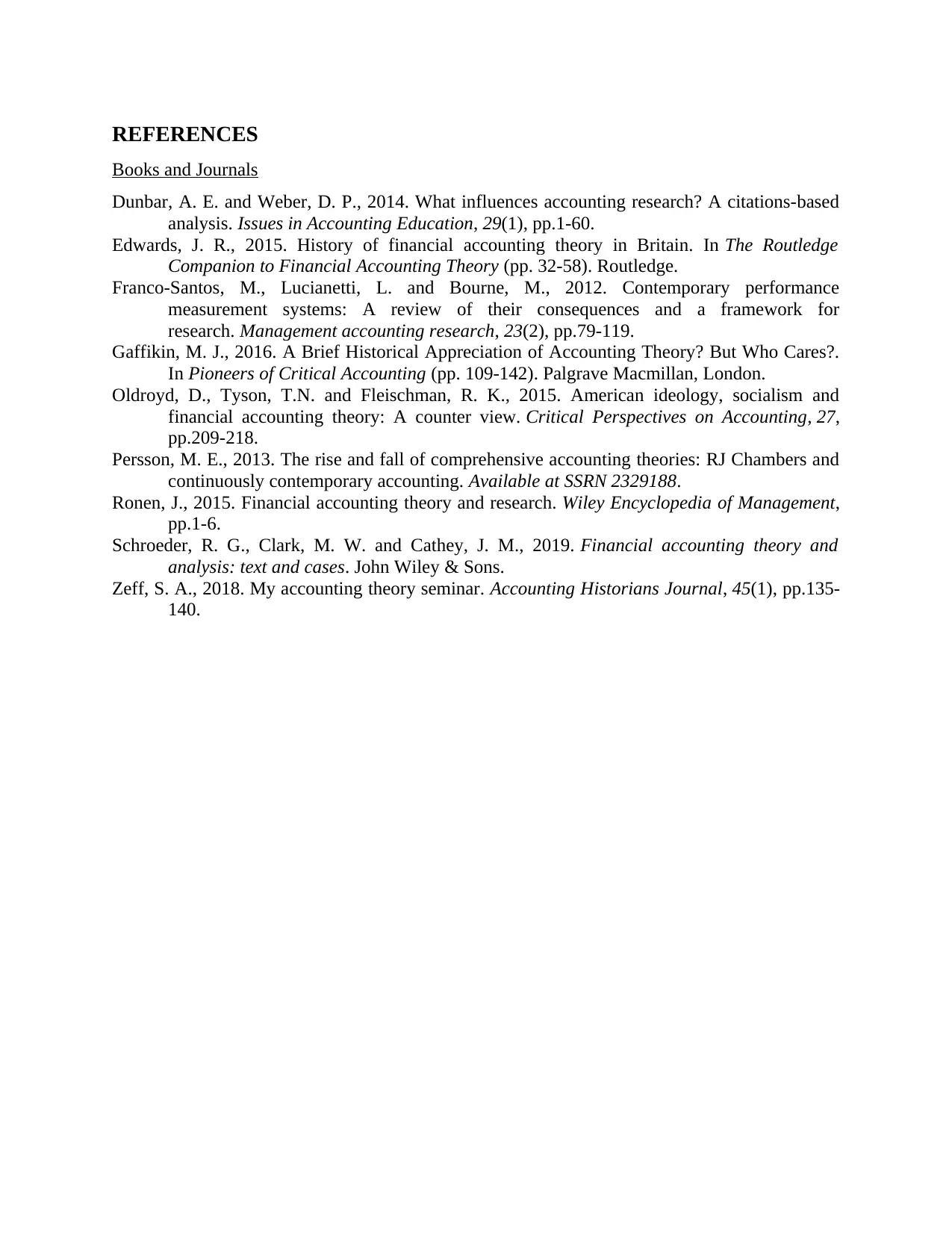
REFERENCES
Books and Journals
Dunbar, A. E. and Weber, D. P., 2014. What influences accounting research? A citations-based
analysis. Issues in Accounting Education, 29(1), pp.1-60.
Edwards, J. R., 2015. History of financial accounting theory in Britain. In The Routledge
Companion to Financial Accounting Theory (pp. 32-58). Routledge.
Franco-Santos, M., Lucianetti, L. and Bourne, M., 2012. Contemporary performance
measurement systems: A review of their consequences and a framework for
research. Management accounting research, 23(2), pp.79-119.
Gaffikin, M. J., 2016. A Brief Historical Appreciation of Accounting Theory? But Who Cares?.
In Pioneers of Critical Accounting (pp. 109-142). Palgrave Macmillan, London.
Oldroyd, D., Tyson, T.N. and Fleischman, R. K., 2015. American ideology, socialism and
financial accounting theory: A counter view. Critical Perspectives on Accounting, 27,
pp.209-218.
Persson, M. E., 2013. The rise and fall of comprehensive accounting theories: RJ Chambers and
continuously contemporary accounting. Available at SSRN 2329188.
Ronen, J., 2015. Financial accounting theory and research. Wiley Encyclopedia of Management,
pp.1-6.
Schroeder, R. G., Clark, M. W. and Cathey, J. M., 2019. Financial accounting theory and
analysis: text and cases. John Wiley & Sons.
Zeff, S. A., 2018. My accounting theory seminar. Accounting Historians Journal, 45(1), pp.135-
140.
Books and Journals
Dunbar, A. E. and Weber, D. P., 2014. What influences accounting research? A citations-based
analysis. Issues in Accounting Education, 29(1), pp.1-60.
Edwards, J. R., 2015. History of financial accounting theory in Britain. In The Routledge
Companion to Financial Accounting Theory (pp. 32-58). Routledge.
Franco-Santos, M., Lucianetti, L. and Bourne, M., 2012. Contemporary performance
measurement systems: A review of their consequences and a framework for
research. Management accounting research, 23(2), pp.79-119.
Gaffikin, M. J., 2016. A Brief Historical Appreciation of Accounting Theory? But Who Cares?.
In Pioneers of Critical Accounting (pp. 109-142). Palgrave Macmillan, London.
Oldroyd, D., Tyson, T.N. and Fleischman, R. K., 2015. American ideology, socialism and
financial accounting theory: A counter view. Critical Perspectives on Accounting, 27,
pp.209-218.
Persson, M. E., 2013. The rise and fall of comprehensive accounting theories: RJ Chambers and
continuously contemporary accounting. Available at SSRN 2329188.
Ronen, J., 2015. Financial accounting theory and research. Wiley Encyclopedia of Management,
pp.1-6.
Schroeder, R. G., Clark, M. W. and Cathey, J. M., 2019. Financial accounting theory and
analysis: text and cases. John Wiley & Sons.
Zeff, S. A., 2018. My accounting theory seminar. Accounting Historians Journal, 45(1), pp.135-
140.
⊘ This is a preview!⊘
Do you want full access?
Subscribe today to unlock all pages.

Trusted by 1+ million students worldwide
1 out of 12
Related Documents
Your All-in-One AI-Powered Toolkit for Academic Success.
+13062052269
info@desklib.com
Available 24*7 on WhatsApp / Email
![[object Object]](/_next/static/media/star-bottom.7253800d.svg)
Unlock your academic potential
Copyright © 2020–2025 A2Z Services. All Rights Reserved. Developed and managed by ZUCOL.





